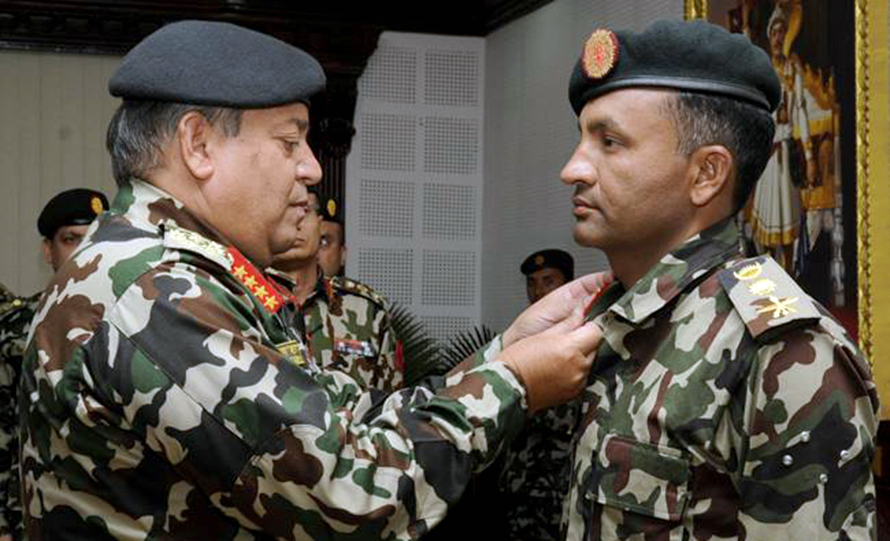From Guerrilla Leader to Top Army Officer: The Journey of Yama Bahadur Adhikari ‘Pratiksha’

Yama Bahadur Adhikari ‘Pratiksha’ embodies the remarkable transformation of a former Maoist guerrilla leader who ascended to one of the highest ranks within the Nepal Army. During the Maoist insurgency, Adhikari demonstrated his military prowess by leading battles against the Nepal Army across the country. However, following the peace process, he not only integrated into the very institution he once fought against but also became one of its most esteemed officers, significantly contributing to national security. This is the story of a warrior who, after years of fierce combat, found himself working alongside his former adversaries under a unified banner.
Early Life and Entry into Maoist Movement
June 14, 1972 (2029 Ashar 1 B.S.): Born in the remote village of Marpak in northern Dhading, Yama Bahadur Adhikari completed his School Leaving Certificate (SLC) before moving to Kathmandu for higher education. While studying in the capital, he became active in student politics, initially aligning with the Mashal faction. His involvement in revolutionary activities soon deepened.
1996 (2052 B.S.): When the Maoist insurgency began, Adhikari became a full-time member of the Communist Party of Nepal (Maoist). He quickly rose through the ranks, leading various units from militia squads to divisions. Adhikari earned the trust of the party leadership, particularly Chairman Pushpa Kamal Dahal ‘Prachanda,’ and was recognized as one of the most capable commanders within the Maoist ranks.
Military Leadership During the Insurgency
2001 (2058 B.S.): Adhikari led a significant battle against the Nepal Army in the Krishnabhir area of Dhading. The Maoists, under his command, managed to ambush the army and seize a substantial amount of weaponry, marking a major victory for the insurgents. This battle further solidified his reputation as a formidable military leader.
Transition to Peace and Integration into the Nepal Army
November 21, 2006 (2063 Mansir 5 B.S.): Following the Comprehensive Peace Agreement between the government and the Maoists, Adhikari was appointed as the Deputy Commander of the Fourth Division in Jhyaltungdanda, Nawalparasi. Initially serving under Ganeshman Pun, Adhikari was later promoted to Division Commander of the First Division in Chulachuli, Ilam, when Pun was reassigned to lead the Young Communist League (YCL) in Kathmandu.
March 12, 2013 (2069 Chaitra 30 B.S.): As part of the peace agreement, Maoist combatants were integrated into the Nepal Army. Among the 1,313 ex-combatants who joined the national army, Adhikari achieved the highest rank of Colonel (Mahasenani), reflecting his esteemed status among the former insurgents.
Achievements in the Nepal Army
October 1, 2019 (2076 Ashoj 1 B.S.): The government led by Prime Minister KP Sharma Oli created a special position for Adhikari, promoting him to Brigadier General (Sahayak Rathi). In this role, he was tasked with directing the Forest and Environmental Security Directorate, a crucial post that highlighted his growing influence within the military establishment.
October 1, 2023 (2080 Ashoj 1 B.S.): As his term was nearing its end, the government extended Adhikari’s service by another three years, allowing him to continue contributing to the Nepal Army. This extension underscored the government's recognition of his valuable service and leadership.
Contributions and Legacy
Yama Bahadur Adhikari’s journey from a Maoist guerrilla commander to a high-ranking officer in the Nepal Army is a testament to his adaptability, leadership, and commitment to national service. His role in the insurgency was pivotal, but his contributions to the peace process and subsequent integration into the national army were equally significant. Adhikari’s ability to transform his military career from revolutionary fervor to patriotic duty has made him a symbol of reconciliation and progress within Nepal’s evolving military landscape. His presence in the Nepal Army continues to enhance the representation of former Maoist combatants, ensuring that their contributions to the nation's security and stability are acknowledged and valued.




![From Kathmandu to the World: How Excel Students Are Winning Big [Admission Open]](https://nepalaaja.com/img/70194/medium/excel-college-info-eng-nep-2342.jpg)
